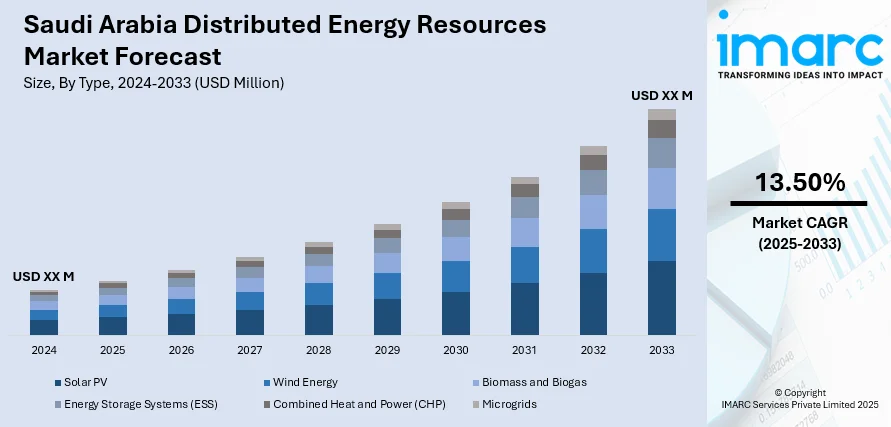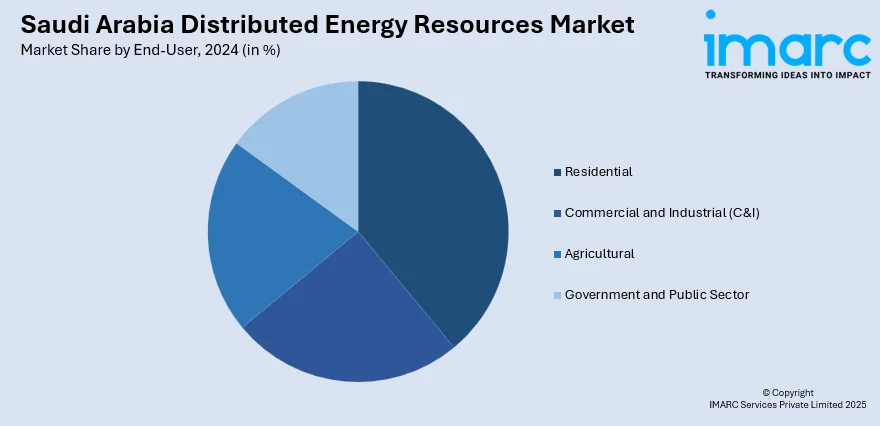
Saudi Arabia Distributed Energy Resources Market Size, Share, Trends and Forecast by Type, Connectivity, Technology, End-User, and Region, 2025-2033
Saudi Arabia Distributed Energy Resources Market Overview:
The Saudi Arabia distributed energy resources market size is projected to exhibit a growth rate (CAGR) of 13.50% during 2025-2033. The market is expanding due to rising solar installations, smart grid automation, and off-grid infrastructure in tourism and agriculture. Vision 2030 goals and private-sector investments are key drivers strengthening decentralized energy adoption and boosting Saudi Arabia distributed energy resources market share.
|
Report Attribute
|
Key Statistics
|
|---|---|
|
Base Year
|
2024 |
|
Forecast Years
|
2025-2033
|
|
Historical Years
|
2019-2024
|
| Market Growth Rate 2025-2033 | 13.50% |
Saudi Arabia Distributed Energy Resources Market Trends:
Private-Sector Solar Projects Driving Adoption
Saudi Arabia’s distributed energy resources market is increasingly shaped by private-sector involvement in grid-connected renewable energy. These initiatives contribute to decentralizing electricity generation while helping the country shift from fossil fuels toward clean energy. As Vision 2030 targets a 50% renewable share in the power mix, utility-scale solar projects under public-private partnerships are enabling significant DER expansion. Such developments are strategically located to feed clean power directly into the grid, supporting regional demand centers while creating long-term investment opportunities. In December 2024, TotalEnergies and Aljomaih Energy & Water secured a 25-year Power Purchase Agreement for the 300 MW Rabigh 2 solar project. The project was part of Round 5 of the National Renewable Energy Program, aimed at achieving an optimal mix of gas and renewables for power generation. This project demonstrated how DER, led by private consortia, is being leveraged for national energy transformation. By integrating renewables at scale, Saudi Arabia is decentralizing its energy landscape and encouraging distributed generation closer to consumption points. These moves not only diversify energy sources but also enhance energy security, resilience, and environmental performance, making solar-based DER a growing pillar of the country’s future electricity system.

Smart Grid Integration for Operational Efficiency
The growing focus on digital infrastructure to support smart grid integration is driving the Saudi Arabia distributed energy resources market growth. Automating electricity networks and incorporating real-time monitoring tools are essential for managing distributed generation and ensuring reliable, efficient power distribution. These technologies provide utilities with the tools to oversee consumption, balance supply, and reduce system losses while enabling consumers to make informed energy choices. This transformation aligns with Vision 2030’s goal of building a resilient, sustainable energy system backed by technology and innovation. In December 2024, Saudi Arabia achieved 32% automation in its distribution networks, with a target of reaching 40% by the end of 2025. Over 11 Million smart meters were already installed, and nine advanced digital control centers are planned for completion by 2026 to support real-time management. These milestones reflect how smart grids are becoming the backbone of DER integration, ensuring that solar, wind, and battery systems can seamlessly interact with the national grid. By building digital intelligence into energy infrastructure, Saudi Arabia is enabling greater DER participation, optimizing load control, and setting a foundation for future innovations in demand-side management, peer-to-peer energy trading, and decentralized resource planning.
Saudi Arabia Distributed Energy Resources Market Segmentation:
IMARC Group provides an analysis of the key trends in each segment of the market, along with forecasts at the country and regional level for 2025-2033. Our report has categorized the market based on type, connectivity, technology, and end-user.
Type Insights:
- Solar PV
- Wind Energy
- Biomass and Biogas
- Energy Storage Systems (ESS)
- Combined Heat and Power (CHP)
- Microgrids
The report has provided a detailed breakup and analysis of the market based on the type. This includes solar PV, wind energy, biomass and biogas, energy storage systems (ESS), combined heat and power (CHP), and microgrids.
Connectivity Insights:
- On-Grid
- Off-Grid
- Hybrid Systems
The report has provided a detailed breakup and analysis of the market based on the connectivity. This includes on-grid, off-grid, and hybrid systems.
Technology Insights:
- Distributed Generation
- Distributed Storage
- Demand Response Technologies
- Smart Grid and IoT Integration
The report has provided a detailed breakup and analysis of the market based on the technology. This includes distributed generation, distributed storage, demand response technologies, and smart grid and IoT integration.
End-User Insights:

- Residential
- Commercial and Industrial (C&I)
- Agricultural
- Government and Public Sector
A detailed breakup and analysis of the market based on the end-user have also been provided in the report. This includes residential, commercial and industrial (C&I), agricultural, and government and public sector.
Regional Insights:
- Northern and Central Region
- Western Region
- Eastern Region
- Southern Region
The report has also provided a comprehensive analysis of all the major regional markets, which include Northern and Central region, Western region, Eastern region, and Southern region.
Competitive Landscape:
The market research report has also provided a comprehensive analysis of the competitive landscape. Competitive analysis such as market structure, key player positioning, top winning strategies, competitive dashboard, and company evaluation quadrant has been covered in the report. Also, detailed profiles of all major companies have been provided.
Saudi Arabia Distributed Energy Resources Market News:
- March 2025: Emerge partnered with Tanmiah Food Company to develop a 3 MWp solar plant at its Haradh facility. Supplying 35% of the site’s energy needs, the project advanced clean power use in agriculture and supported Saudi Arabia’s distributed energy resources market development.
- October 2024: EDF Group and Masdar-led consortium achieved financial close on a USD 1.5 Billion off-grid multi-utilities project at Saudi Arabia’s AMAALA. Featuring 250 MW solar power and 700 MWh storage, the development advanced distributed energy resources integration in luxury tourism and remote infrastructure planning.
Saudi Arabia Distributed Energy Resources Market Report Coverage:
| Report Features | Details |
|---|---|
| Base Year of the Analysis | 2024 |
| Historical Period | 2019-2024 |
| Forecast Period | 2025-2033 |
| Units | Million USD |
| Scope of the Report |
Exploration of Historical Trends and Market Outlook, Industry Catalysts and Challenges, Segment-Wise Historical and Future Market Assessment:
|
| Types Covered | Solar PV, Wind Energy, Biomass and Biogas, Energy Storage Systems (ESS), Combined Heat and Power (CHP), Microgrids |
| Connectivities Covered | On-Grid, Off-Grid, Hybrid Systems |
| Technologies Covered | Distributed Generation, Distributed Storage, Demand Response Technologies, Smart Grid and IoT Integration |
| End Users Covered | Residential, Commercial and Industrial (C&I), Agricultural, Government and Public Sector |
| Regions Covered | Northern and Central Region, Western Region, Eastern Region, Southern Region |
| Customization Scope | 10% Free Customization |
| Post-Sale Analyst Support | 10-12 Weeks |
| Delivery Format | PDF and Excel through Email (We can also provide the editable version of the report in PPT/Word format on special request) |
Key Questions Answered in This Report:
- How has the Saudi Arabia distributed energy resources market performed so far and how will it perform in the coming years?
- What is the breakup of the Saudi Arabia distributed energy resources market on the basis of type?
- What is the breakup of the Saudi Arabia distributed energy resources market on the basis of connectivity?
- What is the breakup of the Saudi Arabia distributed energy resources market on the basis of technology?
- What is the breakup of the Saudi Arabia distributed energy resources market on the basis of end-user?
- What is the breakup of the Saudi Arabia distributed energy resources market on the basis of region?
- What are the various stages in the value chain of the Saudi Arabia distributed energy resources market?
- What are the key driving factors and challenges in the Saudi Arabia distributed energy resources market?
- What is the structure of the Saudi Arabia distributed energy resources market and who are the key players?
- What is the degree of competition in the Saudi Arabia distributed energy resources market?
Key Benefits for Stakeholders:
- IMARC’s industry report offers a comprehensive quantitative analysis of various market segments, historical and current market trends, market forecasts, and dynamics of the Saudi Arabia distributed energy resources market from 2019-2033.
- The research report provides the latest information on the market drivers, challenges, and opportunities in the Saudi Arabia distributed energy resources market.
- Porter's five forces analysis assist stakeholders in assessing the impact of new entrants, competitive rivalry, supplier power, buyer power, and the threat of substitution. It helps stakeholders to analyze the level of competition within the Saudi Arabia distributed energy resources industry and its attractiveness.
- Competitive landscape allows stakeholders to understand their competitive environment and provides an insight into the current positions of key players in the market.
Need more help?
- Speak to our experienced analysts for insights on the current market scenarios.
- Include additional segments and countries to customize the report as per your requirement.
- Gain an unparalleled competitive advantage in your domain by understanding how to utilize the report and positively impacting your operations and revenue.
- For further assistance, please connect with our analysts.
 Request Customization
Request Customization
 Speak to an Analyst
Speak to an Analyst
 Request Brochure
Request Brochure
 Inquire Before Buying
Inquire Before Buying




.webp)




.webp)












